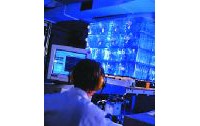Advertisement
Grab your lab coat. Let's get started
Welcome!
Welcome!
Create an account below to get 6 C&EN articles per month, receive newsletters and more - all free.
It seems this is your first time logging in online. Please enter the following information to continue.
As an ACS member you automatically get access to this site. All we need is few more details to create your reading experience.
Not you? Sign in with a different account.
Not you? Sign in with a different account.
ERROR 1
ERROR 1
ERROR 2
ERROR 2
ERROR 2
ERROR 2
ERROR 2
Password and Confirm password must match.
If you have an ACS member number, please enter it here so we can link this account to your membership. (optional)
ERROR 2
ACS values your privacy. By submitting your information, you are gaining access to C&EN and subscribing to our weekly newsletter. We use the information you provide to make your reading experience better, and we will never sell your data to third party members.
Business
Business Concentrates
March 21, 2005
| A version of this story appeared in
Volume 83, Issue 12
Thomas M. Connelly Jr., DuPont's chief science and technology officer, told a Merrill Lynch chemical conference in New York City last week that his company achieved 30% of its sales, or some $7.4 billion, from new products last year, up from 22% of sales in 2000. DuPont's target for 2005 is 33% of sales from new products, which the company defines as those less than five years old. At the same time, DuPont's patent applications have more than doubled since 2001, to 1,668 in 2004. The company is cutting the time it takes to commercialize a new product, Connelly said. In DuPont's imaging business, for example, time-to-market has fallen by 42% since 2000, to about 23 months last year. Connelly described a "traction index" the firm introduced last year to realistically predict the potential sales from its top 75 new products under development. He said these products should add more than $2 billion in sales by 2007.
Sasol expands, draws interest as a takeover
Sasol plans to increase capacity of isopropanol and methyl ethyl ketone by a total of 20,000 metric tons per year at its German solvents plant. The firm is also recommissioning a mothballed 60,000-metric-ton-per-year ethanol distillation plant in Herne, Germany, and upgrading it to convert bioethanol to fuel-grade ethanol. Separately, rumors have surfaced that the South African company might be the target of a takeover by a U.S. firm. Trading in the company's shares on the New York Stock Exchange jumped significantly on March 11, and the company's share price rose 2.5% to close at $25.52. Sasol says there is no truth to the rumors.
BASF revamps plasticizers
BASF is investing $60 million to restructure its North American plasticizer business to make way for a new plasticizer, dipropyl heptyl phthalate (DPHP). The company will convert a 125,000-metric-ton-per-year 2-ethylhexanol (2-EH) unit in Pasadena, Texas, to one that makes 120,000 metric tons of 2-propylheptanol (2-PH). BASF is also building a 125,000-metric-ton phthalate ester facility in Pasadena to start up with the 2-PH unit in the second half of 2006. To make up for some of the 2-EH it is losing in these moves, the company has increased its 2-EH capacity in Freeport, Texas, by 50% to 120,000 metric tons. The company says the restructuring is part of a transition from ethylene- to butene-based feedstocks in its plasticizer business. It adds that DPHP plasticizers offer similar performance to conventional ones.
DyStar expands in China
As part of its effort to shift production eastward, German dyes maker DyStar broke ground on a $55 million textile dyes facility in Nanjing, China. Scheduled to open in the first half of 2006, the facility will create 400 jobs and produce dyes for both cellulosic and synthetic fibers. China will account for 40% of global textile output "in the medium term," the firm says. Between offices in Shanghai and Hong Kong and plants in Wuxi and Qingdao, DyStar already employs more than 300 people in China.
ISP acquires BP BDO plant
International Specialty Products has acquired BP's butanediol (BDO) plant in Lima, Ohio, for an undisclosed sum. The Lima plant, with annual capacity for 60,000 metric tons, started up in 2000 based on technology developed by BP and Lurgi to make BDO directly from butane. ISP is a major consumer of BDO to make the solvent N-methyl-2-pyrrolidone and other products. It says it will continue to supply existing BP customers.
Ferro will restructure
Seeking to accelerate earnings growth, Ferro has announced a restructuring program to reduce its global overhead structure. Ferro, which expects to record a related pretax charge of $5 million to $6 million in first-quarter 2005, sees the program resulting in $10 million in annual savings. The new program follows a restructuring of Ferro's polymer additives division, which resulted in a $2 million pretax charge in fourth-quarter 2004. In addition, the company says it will continue to evaluate other potential restructuring actions to reduce its cost base. Last week, Ferro reported fourth-quarter income from continuing operations of $1.69 million on sales of $440.5 million.

Firms develop nanocoatings
Ecology Coatings will work together with NanoDynamics and its subsidiary MetaMateria Partners to develop polymer nanocomposite coatings. The UV-curable coatings will combine organic polymers and inorganic nanomaterials for improved protective performance and aesthetics. The companies say the new coatings can be easily adopted by the automotive and metals industries. Separately, Eikos, a developer of carbon nanotube formulations for conductive coatings, has launched its Invisicon ink for creating printed circuits on clear, flexible plastic. According to the company, the conductive inks can be applied in patterns using modified conventional printing methods.
Huntsman boosts MDI capacity
Huntsman Corp. is increasing capacity at two of its methylene diphenyl diisocyanate (MDI) plants. The company will expand its Geismar, La., facility by 15% to 990 million lb per year. It will up production in Rozenburg, the Netherlands, by a third to 880 million lb. The company says the expansions will come on in stages through late 2006. Between these expansions and a 265 million-lb joint venture being built in Caojing, China, Huntsman's total capacity will exceed 2.1 billion lb. The company says growing demand, especially in Asia, has spurred the investments. In its recent year-end results conference, competitor Bayer said it is sold out of MDI.
Actelion gets Merck payment
Merck has issued a $5 million milestone payment to the Swiss firm Actelion. The payment was triggered when the first compound from the firms' renin inhibitor alliance entered preclinical development. Renin is a cardiovascular-regulating enzyme that is part of a pathway involved in high blood pressure and heart failure. Inhibition of this enzyme may help treat hypertension, kidney failure, and vascular diseases.
Epimmune, IDM to combine
Two small drug discovery companies, San Diego's Epimmune and Paris-based IDM, will merge in an all-stock transaction. The new company, to be called IDM, will be owned 78% by IDM shareholders and 22% by Epimmune shareholders. It will employ about 150 people and have $41 million in cash, enough, it says, to last 18 to 24 months. Its lead product will be the former IDM's Mepact, which has completed a Phase III clinical trial for the treatment of osteosarcoma.
Pact formed to map soybean
Monsanto, biotech company Genaissance, and USDA are collaborating to create a map of the soybean's genome. The information will be made available in Soybase, USDA's soybean database; in dbSNP, the National Center for Biotechnology Information's single nucleotide polymorphism (SNP) database; and in scientific journals. Monsanto will fund and Genaissance will carry out the mapping, which will involve SNP DNA markers that were discovered at USDA with support from the United Soybean Board.
Chemical output rises a little
U.S. chemical production in February increased from both the previous month and year-earlier levels, according to seasonally adjusted data from the Federal Reserve Board. The government reports a February chemical production index of 112.1 (1997 = 100), up just 0.1% from January and 4.2% ahead of February 2004. The government's estimate of seasonally adjusted capacity utilization for all chemicals in February was 76.3%, a bit below January's 76.4%, but up from 73.7% in February of last year. Meanwhile, the production index for basic chemicals declined 0.9% from the previous month to 95.6; however, it was up 5.2% from the comparable month last year.
Ranbaxy R&D chief departs
New Delhi, India-based Ranbaxy says it has reluctantly accepted the resignation of Rajinder Kumar, its head of R&D, who is returning to the U.K. due to "personal circumstances" eight months after joining the company from GlaxoSmithKline. As a result of his departure, Ranbaxy will split its R&D operations into two separately managed areas, one focusing on generics and the other on drug discovery. The firm derives most of its income from the sale of generics, but it has an antimalaria drug in Phase II clinical trials.
Public-private RNAi effort
A public-private effort called the RNAi Consortium has been formed to create a library of gene inhibitors for use in basic research and drug discovery. The library will create and validate reagents and tools to knock down human and mouse genes using the method of RNA interference. The reagents will be composed of short RNA sequences carried in lentiviral vectors. The consortium is based at the Broad Institute, an alliance of Massachusetts Institute of Technology, Whitehead Institute for Biomedical Research, and Harvard University. The consortium includes six other Boston-area research institutions, plus Sigma-Aldrich, Bristol-Myers Squibb, Eli Lilly, Novartis, and a Taiwanese academic consortium called Academica Sinica-National Science Council. The combined companies and the Taiwan group will each put $3.6 million toward the three-year project.
BUSINESS ROUNDUP
- BASF and Japan's Sakai Chemical will work together to develop new grades of microfine titanium dioxide used in making sun protection creams. BASF says Sakai has expertise in nanotechnology and powder modification.
- Sumitomo Chemical will quadruple production of its long-lasting antimalarial mosquito net, Olyset Net, to 20 million units per year. To broaden distribution, Sumitomo says it will freely license its net technology.
- Tripos has been awarded an $860,000 Small Business Innovation Research grant from NIH. The firm will use the funds to apply topomer, or shape-based, technology to accelerate searching through compound libraries 1 million times faster than is currently feasible.
- Showa Denko plans to make its agrochemical subsidiary, SDS Biotech, into an independent company by way of a management buyout backed by Mizuho Capital Partners. The subsidiary had sales of about $12.6 million in its last fiscal year.
- Cyclics Corp. has started up its first plant for cyclic butadiene terephthalate resins. The unit, in Schwarzheide, Germany, can make 5.5 million lb of resins per year for compounding, composites, casting, injection molding, and rotational molding.
- Accelrys says five new members have joined its nanotechnology consortium, formed to foster collaboration between scientists and engineers. The new members are Johnson Matthey, Schenectady International, Fraunhofer IFAM, Fraunhofer IZM, and the Japan Advanced Institute of Science & Technology.





Join the conversation
Contact the reporter
Submit a Letter to the Editor for publication
Engage with us on Twitter